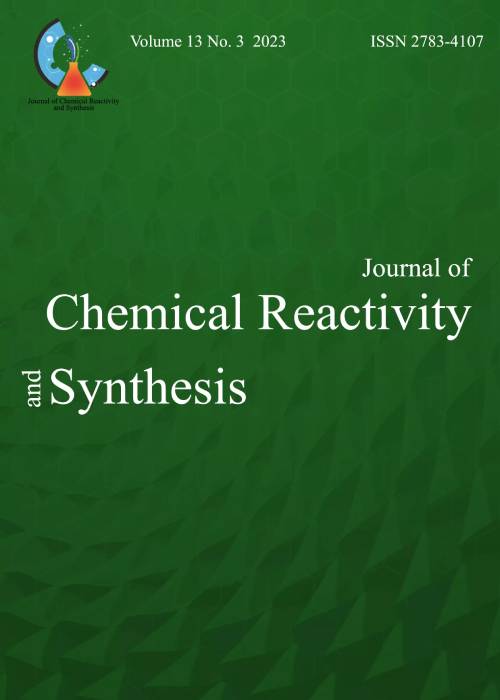فهرست مطالب
Journal of Chemical Reactivity and Synthesis
Volume:7 Issue: 4, Autumn 2017
- تاریخ انتشار: 1395/11/12
- تعداد عناوین: 5
-
Interaction of Prolin, Leucine and methylurea with inorganic cluster [(PO4)M12O36].nH2O; (M = Mo, W)Pages 1-8
Three new inorganic-organic hybrid materials based on heteropolyoxometalates, [L-C6H14NO2]3[(PO4)Mo12O36].3H2O (1), [L-C5H10NO2]3[(PO4)W12O36].H2O (2), and [C2H7N2O]3[(PO4)W12O36]. 4H2O (3), where C6H14NO2, C5H10NO2, and C2H7N2O are protonated L-leucine, L-proline, and methylurea, respectively, have been synthesized and structurally characterized by some physico-chemical methods. Elemental analyses, IR, Raman, mass, UV, and 1H NMR spectroscopies of the title hybrid materials indicate that there are van der Waals interactions between O atoms of the heteropolyoxometalates and water molecules, as well as the N and O atoms of the amino acids and methyl urea moieties. The molecular structures of synthesized hybrid materials contain discrete entities of L-leucinium, L-prolinium or methyluronium and water molecules that surround every [(PO4)M12O36]3- anion, over the extended crystalline network. The observed bands in Raman spectra of 2 and 3 demonstrate that [(PO4)W12O36]3- anion retains its “Keggin structure”. Between pH =7 and pH =4 the characteristic bands of the Keggin anion [(PO4)M12O36]3−(M = Mo, W) appear at 210 and 260 nm in the UV spectra, respectively.
Keywords: Polyoxometalate, L-leucine, L-proline, Methylurea, Inorganic-organic hybrid, IR, Raman, UV, ICP -
Pages 23-28
A novel, simple and environmentally friendly method is reported for the preparation of 1,8-dioxo-octahydroxanthene derivatives by the reaction of dimedon with various aromatic aldehydes, using thiamine chloride as a recyclable catalyst under solvent-free conditions. This procedure has following benefits; simple workup, moderate reaction times, good yields, and completely compatible with environment.
Keywords: octahydroxanthene, thiamine chloride, Solvent-free, dimedon -
Pages 29-37
Treatment of 7-chloro-1-phenylpyrimido[4,5-e][1,3,4]thiadiazines with hydrazine in boiling ethanol gave corresponding7-hydrazinyl derivatives. Diazotization of the latter compounds acheived a mixture of 5H-tetrazolo[1',5':1,2]pyrimido[4,5-e][1,3,4]thiadiazine and 9H-tetrazolo[5',1':2,3]pyrimido[4,5-e][1,3,4]thiadiazines. Ratio of these two group of products determined by 1HNMR studies and no significant preference was observed for their formation. Efforts for separation of the products were unsuccessful and its reason is discussed.
Keywords: trisubstitution, imidazole, solvent free -
Pages 38-47
TiO2 nanoparticles/melamine Tri sulfonic acid (MTSA) supported on silica gel as an efficient catalytic system for simple, one pot, solvent-free and environmentally benign process for synthesis of dihydropyrimidines via Biginelli reaction at 110 °C is described. It was found that the catalyst is reusable and exhibited remarkable activity. The catalyst can be easily separated and reused several times without appreciable loss of activity. The availability and recoverability of the catalytic system with easy operation and work up make this catalytic system attractive for organic synthesis.
Keywords: TiO2 nano particles, Biginelli reaction, dihydropirimidinone, Solvent-free -
Pages 48-51
The Pechmann condensation has been used as a simple and efficient method for the preparation of coumarin derivatives, which phenols and ethyl acetoacetate were reacted in the presence of AlCl3 supported on nano silica as an efficient catalyst at 110 oC under solvent free condition to form products with good to excellent yield (55 -90%), which are identified by spectroscopic method ( FT-IR, NMR) and melting points and compared with reference samples.
Keywords: Pechmann condensation, AlCl3, SiO2NPs, coumarin, phenols


